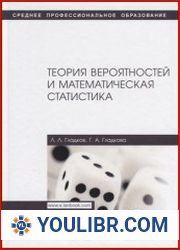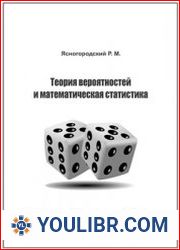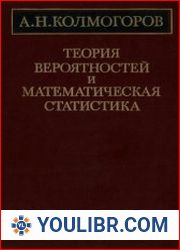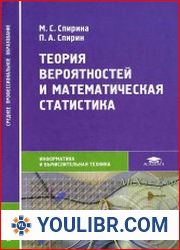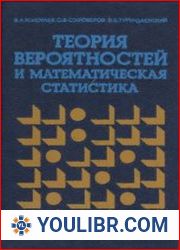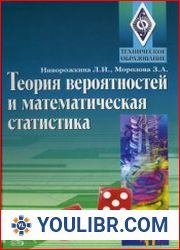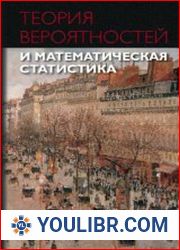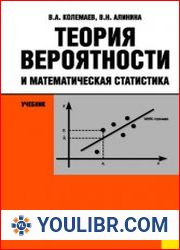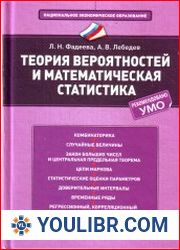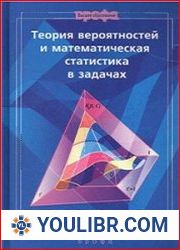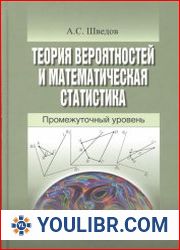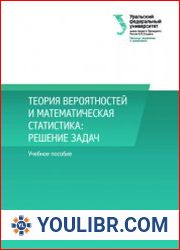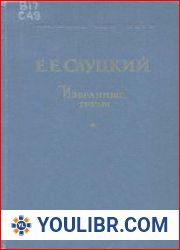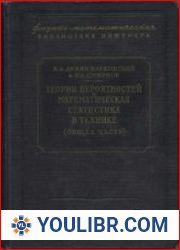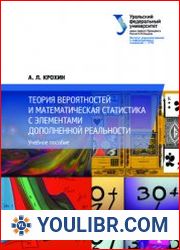
BOOKS - SCIENCE AND STUDY - Теория вероятностей и математическая статистика, математи...

Теория вероятностей и математическая статистика, математические модели
Author: Мятлев В.Д.
Year: 2009
Format: PDF
File size: 26 MB
Language: RU
Year: 2009
Format: PDF
File size: 26 MB
Language: RU
The manual mainly describes the analysis of biological data and uses methods of probability theory and mathematical statistics as a basis; simulation of dynamics of biological processes based on application of mathematical apparatus of differential equations is presented.
The book "Теория вероятностей и математическая статистика" (Theory of Probabilities and Mathematical Statistics) is a comprehensive guide to understanding the principles of probability theory and statistical analysis, and their applications in various fields such as biology, medicine, and engineering. The book provides a thorough explanation of the fundamental concepts of probability theory, including random variables, probability distributions, and stochastic processes, and demonstrates how these concepts can be applied to real-world problems. The first chapter of the book introduces the reader to the basics of probability theory, including the concept of a probability space, events, and conditional probability. The author emphasizes the importance of understanding these basic concepts in order to fully appreciate the power of probability theory in modeling complex systems. The second chapter delves into the study of random variables, including their definition, distribution, and properties. This chapter also covers the concept of independence and conditionality, which are crucial in understanding the relationships between random variables. The third chapter explores the different types of probability distributions, including the normal, binomial, and Poisson distributions, and discusses their applications in various fields. The author highlights the importance of selecting the appropriate distribution for modeling real-world data, and provides examples of how each distribution can be used to represent different types of data. The fourth chapter introduces the reader to stochastic processes, including Markov chains and Brownian motion, and demonstrates how these processes can be used to model complex systems such as population dynamics and financial markets. The fifth chapter focuses on mathematical statistics, including statistical inference and hypothesis testing. The author explains the importance of statistical inference in making conclusions about populations based on samples, and provides examples of common techniques such as t-tests and ANOVA. книга «Теория вероятностей и математическая статистика» (Теория Вероятностей и Математической Статистики) является подробным руководством по пониманию принципов теории вероятности и статистического анализа и их применений в различных областях, таких как биология, медицина и разработка. В книге дается подробное объяснение фундаментальных концепций теории вероятностей, включая случайные величины, распределения вероятностей и стохастические процессы, и демонстрируется, как эти концепции могут быть применены к задачам реального мира. Первая глава книги знакомит читателя с основами теории вероятностей, включая понятие вероятностного пространства, событий и условной вероятности. Автор подчеркивает важность понимания этих основных понятий, чтобы в полной мере оценить силу теории вероятностей при моделировании сложных систем. Вторая глава углубляется в изучение случайных величин, включая их определение, распределение и свойства. Эта глава также охватывает концепцию независимости и обусловленности, которые имеют решающее значение для понимания отношений между случайными величинами. Третья глава исследует различные типы вероятностных распределений, включая нормальное, биномиальное и пуассоновское распределения, и обсуждает их применение в различных областях. Автор подчеркивает важность выбора подходящего распределения для моделирования реальных данных и приводит примеры того, как каждое распределение может использоваться для представления различных типов данных. Четвертая глава знакомит читателя со стохастическими процессами, включая цепи Маркова и броуновское движение, и демонстрирует, как эти процессы можно использовать для моделирования сложных систем, таких как динамика населения и финансовые рынки. Пятая глава посвящена математической статистике, включая статистический вывод и проверку гипотез. Автор объясняет важность статистического вывода при создании выводов о популяциях на основе выборок и приводит примеры общих методов, таких как t-тесты и ANOVA. 下载 pdf 文件 概率論與數學統計,數學模型
PDFファイルをダウンロード להוריד קובץ PDF תורת ההסתברות וסטטיסטיקה מתמטית, מודלים מתמטיים descargar archivo pdf Teoría de probabilidades y estadísticas matemáticas, modelos matemáticos pobierz plik pdf Teoria prawdopodobieństwa i statystyki matematyczne, Modele matematyczne descarregar ficheiro pdf download pdf file تنزيل ملف pdf télécharger le fichier pdf Théorie des probabilités et statistiques mathématiques, modèles mathématiques pdf dosyasını indir Olasılık Teorisi ve Matematiksel İstatistik, Matematiksel Modeller Scarica il file pdf Teoria delle probabilità e statistiche matematiche, modelli matematici скачать файл PDF Теория вероятностей и математическая статистика, математические модели pdf 파일 다운로드 download pdf file Теория вероятностей и математическая статистика, математические модели PDF-Datei herunterladen Wahrscheinlichkeitstheorie und mathematische Statistik, mathematische Modelle
Nel manuale di formazione vengono descritte principalmente questioni relative all'analisi dei dati biologici e si utilizzano metodi di teoria delle probabilità e statistiche matematiche come base; presentata una simulazione della dinamica dei processi biologici basata sull'applicazione dell'apparecchio matematico delle equazioni differenziali.
The manual mainly describes the analysis of biological data and uses methods of probability theory and mathematical statistics as a basis; simulation of dynamics of biological processes based on application of mathematical apparatus of differential equations is presented.
Le manuel décrit principalement les questions d'analyse des données biologiques et utilise comme base les méthodes de la théorie des probabilités et des statistiques mathématiques ; une modélisation de la dynamique des processus biologiques basée sur l'application de l'appareil mathématique des équations différentielles est présentée.
В учебном пособии изложены преимущественно вопросы анализа биологических данных и в качестве основы использованы методы теории вероятностей и математической статистики; представлено моделирование динамики биологических процессов, основанное на применении математического аппарата дифференциальных уравнений.
O manual de treinamento refere principalmente questões de análise de dados biológicos e usa técnicas de teoria de probabilidades e estatísticas matemáticas como base; uma simulação de dinâmica de processos biológicos baseada na aplicação de um aparelho matemático de equações diferenciais.
Im Lehrbuch werden vorwiegend Fragen der biologischen Datenanalyse behandelt und Methoden der Wahrscheinlichkeitstheorie und der mathematischen Statistik als Grundlage herangezogen; wird die Modellierung der Dynamik der biologischen Prozesse, die auf der Anwendung des mathematischen Apparates der Differentialgleichungen gegründet ist vorgestellt.
En el manual se esbozan principalmente cuestiones relacionadas con el análisis de datos biológicos y se utilizan como base técnicas de teoría de la probabilidad y estadísticas matemáticas; se presenta una simulación de la dinámica de los procesos biológicos, basada en la aplicación de un aparato matemático de ecuaciones diferenciales.
Nel manuale di formazione vengono descritte principalmente questioni relative all'analisi dei dati biologici e si utilizzano metodi di teoria delle probabilità e statistiche matematiche come base; presentata una simulazione della dinamica dei processi biologici basata sull'applicazione dell'apparecchio matematico delle equazioni differenziali.
The manual mainly describes the analysis of biological data and uses methods of probability theory and mathematical statistics as a basis; simulation of dynamics of biological processes based on application of mathematical apparatus of differential equations is presented.
Le manuel décrit principalement les questions d'analyse des données biologiques et utilise comme base les méthodes de la théorie des probabilités et des statistiques mathématiques ; une modélisation de la dynamique des processus biologiques basée sur l'application de l'appareil mathématique des équations différentielles est présentée.
В учебном пособии изложены преимущественно вопросы анализа биологических данных и в качестве основы использованы методы теории вероятностей и математической статистики; представлено моделирование динамики биологических процессов, основанное на применении математического аппарата дифференциальных уравнений.
O manual de treinamento refere principalmente questões de análise de dados biológicos e usa técnicas de teoria de probabilidades e estatísticas matemáticas como base; uma simulação de dinâmica de processos biológicos baseada na aplicação de um aparelho matemático de equações diferenciais.
Im Lehrbuch werden vorwiegend Fragen der biologischen Datenanalyse behandelt und Methoden der Wahrscheinlichkeitstheorie und der mathematischen Statistik als Grundlage herangezogen; wird die Modellierung der Dynamik der biologischen Prozesse, die auf der Anwendung des mathematischen Apparates der Differentialgleichungen gegründet ist vorgestellt.
En el manual se esbozan principalmente cuestiones relacionadas con el análisis de datos biológicos y se utilizan como base técnicas de teoría de la probabilidad y estadísticas matemáticas; se presenta una simulación de la dinámica de los procesos biológicos, basada en la aplicación de un aparato matemático de ecuaciones diferenciales.












